DNV动力定位规范
DNV规范电气章节5
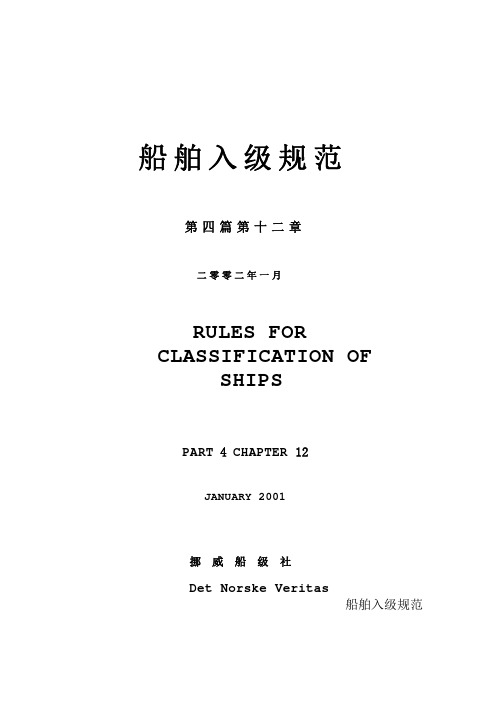
船舶入级规范第四篇第十二章二零零二年一月RULES FOR CLASSIFICATION OFSHIPSPART 4 CHAPTER 12JANUARY 2001挪威船级社Det Norske Veritas船舶入级规范新造船舶机械与系统主船级 第4篇第12章GMDSS 及内部通信2001年1月节 页 1 GMDSS(全球海难及安全系统) (1)2 内部通信 (10)规范更改说明综述理事会2000年12月和2001年6月确定了包括增补和修订在内的现行规范版本,并以此更换本章的1999年7月版。
本章规范的更改于2002年1月1日生效。
本章在被新的修订版替换之前有效。
改版前对规范所作的少量修正和勘误,仅列表刊载在序言分册中,不发增刊。
序言分册通常于每年1月及7月修改。
修改过的各章将发给本规范的所有订户。
建议再版本的购买者核对刊印在第0篇第1章第1节的规范各章的最新目录,以确认该章为现行版本。
主要更改●综述— 新的机械方案要求重新调整第4篇的机械部分内容。
调整的结果是将第9章改编入第12章。
勘误和澄清除了上述的规范修正外,还对规范中某些已发现的错误作了改正,对原规范的措词也做了一些澄清。
第1节 GMDSS(全球性海难及安全系统) (1)A. 一般要求 (1)A 100 适用范围 (1)A 200 GMDSS 装置入级 (1)A 300 型式认可 (2)A 400 改进及附加 (2)A 500 术语、定义及缩写 (2)A 600 免除 (3)B. 船舶要求 (3)B 100 功能要求 (3)B 200 无线电装置 (3)B 300 无线电设备–通则 (4)B 400 无线电设备–海区A1 (4)B 500 无线电设备–海区A1和A2 (5)B 600 无线电设备–海区A1,A2和A3 (6)B 700 无线电设备–海区A1,A2,A3和A4 (7)B 800 值班 (7)B 900 电源 (7)B 1000 性能标准 (8)B 1100 维护要求 (9)B 1200 无线电记录 (9)B 1300 无线电救生装置..................... 9 第2节 内部通信.. (10)A. 一般要求 (10)A 100 应用 (10)A 200 入级 (10)A 300 设计文件 (10)A 400 ATOS 或厂商生产认证书 (10)A 500 船上测量及功能测试 (10)A 600 术语、定义及缩写 (10)B. 船用要求–主船级 (11)B 100 双向电话通信 (11)B 200 播音系统/ 全船报警装置 (11)B 300 电力要求 (12)C. 船用要求–附加等级 (12)C 100 渔船 (12)C 200 油船 (12)C 300 定期无人值班机舱 (12)C 400 动力定位系统 (13)C 500 海上安全 (13)目录A.一般要求A 100 适用范围101 本章要求符合国际海上人命安全公约(SOLAS)第3章和最近修正的第4章中提及规则的第6条,即有关无线电救生装置的内容。
UT771

UT771摘要:本文简要介绍DP(Dynamic Positioning System)动力定位系统的定义,入级附加标志(DP1,DP2,DP3)的基本要求,现以海工平台供应船UT771 WP的工程项目实例进行动力定位系统设计研究,该船入级满足DNV动力定位2级要求,并在DNV检测下进行安装与测试,试验满足DNV动力定位2级要求,主要包括DP操作站,DP主控制箱,信号接口箱, 外围设备, 位置参考系统, 传感器, 独立操作杆系统和相关的操作模式,该文是规则的快速指南,有助于改善船厂,船东和制造商对动力定位系统有更深入的了解,对国内其他准备建造动力定位系统船舶项作一个参考。
关键词:动力定位,位置参考系统,冗余1 定义1.1动力定位船舶:系指仅用推进器的推力保持其自身位置(固定的位置或预先确定的航迹)的船舶。
1.2动力定位系统:系指使动力定位船舶实现动力定位所必须的一整套系统,包括下列分系统:(1)动力源系统(2)推进器系统(3)动力定位控制系统(4)独立操作杆系统1.3入级标志:(1)DYNPOS AUT(DP1)——安装有动力定位系统的船舶,可在规定的环境条件下,自动保持船舶的位置和首向,同时还应设有独立的集中手动船位控制和自动首向控制。
有一套备用遥控推进控制系统和一套备用位置参考信号系统。
(2)DYNPOS AUTR(DP2)——安装有动力定位系统的船舶,在出现单个故障(不包括一个舱室或几个舱室的损失)后,可在规定的环境条件下,在规定的作业范围内自动保持船舶的位置和首向。
自动位置保持系统,技术设计有冗余。
(3)DYNPOS AUTRO(DP3)——安装有动力定位系统的船舶,在出现任一故障(包括由于失火或进水造成一个舱室的完全损失)后,可在规定的环境条件下,在规定的作业范围内自动保持船舶的位置和首向。
自动位置保持系统,技术设计和布置有冗余。
2 系统配置DNV 船级社对动力定位系统不同的入级标志有不同的系统配置要求。
DNV规范

DNV规范(船舶)1998A500 非破坏性试验(NDT)501 一般,焊接接头外表面(包括管子内部可能的区域)要经过外观检查,按管系的级别和接头型式进行无损检测。
对接接头:✧外径大于76.1mm的I级管系,要求100%射线检测,✧外径大于101.6mm的II级管系和外径≤76.1mm的I级管系,至少要10%射线检测。
根据验船师要求,对各种材料要做焊接程序过程控制认可。
角焊:✧对外径大于76.1mm的I级管系,法兰联接的角焊,要求100磁粉检测。
✧对外径大于101.6mm的II级管系和外径≤76.1mm的I级管系,按验船师要求做磁粉检测抽查。
对热油管系对接接头至少附加10%射线检测。
503当焊接质量被认可的条件下,超声波检测可以代替射线检测,对非铁磁性材料,用着色渗透代替磁粉检查。
504NDT是靠操作者根据认可的计划、使用合适的设备和程序来完成的,射线检测要在管线上容易被标识的位置做出标记。
505射线检测按照ISO5817《钢电弧焊焊接接头缺陷质量等级参考》,对于I级管管系焊接用B级质量等级验收,其它用C级。
表面检查(MT、PT)满足ISO5817 B级要求。
506无损检测期间缺陷修理根据验船师同意执行,所有焊接修理要用相关联的检验方法。
D100 无损探伤的范围101 I级压力容器,无损探伤按如下执行:a)筒体、外壳和封头纵向对接焊接接头须100%射线探伤。
b)筒体、外壳和封头环向对接焊接接头须按长度的25%射线探伤。
c)小管和大径管环向对接焊接接头须按总数的10%射线探伤。
d)对筒体外壳嵌入式平板要用超声波检测环缝和平板联接处的层状撕裂。
板厚不大于15mm的外壳板探测范围至少10%,板厚大于15mm至少焊缝总长的20%。
填角焊见第5部分图8,要对表面做100%磁粉检验。
e)对外径超过100mm的竖管和支管,所有与外壳联接处的焊缝及加强板要做磁粉探伤,对于外径不大于100mm,要做点状(少量)检查,外壳与加强板的焊接接头也要做磁粉检测。
dnv规范
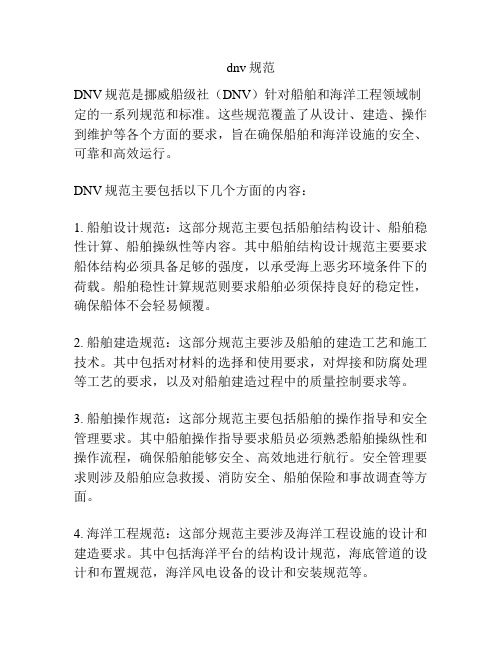
dnv规范
DNV规范是挪威船级社(DNV)针对船舶和海洋工程领域制定的一系列规范和标准。
这些规范覆盖了从设计、建造、操作到维护等各个方面的要求,旨在确保船舶和海洋设施的安全、可靠和高效运行。
DNV规范主要包括以下几个方面的内容:
1. 船舶设计规范:这部分规范主要包括船舶结构设计、船舶稳性计算、船舶操纵性等内容。
其中船舶结构设计规范主要要求船体结构必须具备足够的强度,以承受海上恶劣环境条件下的荷载。
船舶稳性计算规范则要求船舶必须保持良好的稳定性,确保船体不会轻易倾覆。
2. 船舶建造规范:这部分规范主要涉及船舶的建造工艺和施工技术。
其中包括对材料的选择和使用要求,对焊接和防腐处理等工艺的要求,以及对船舶建造过程中的质量控制要求等。
3. 船舶操作规范:这部分规范主要包括船舶的操作指导和安全管理要求。
其中船舶操作指导要求船员必须熟悉船舶操纵性和操作流程,确保船舶能够安全、高效地进行航行。
安全管理要求则涉及船舶应急救援、消防安全、船舶保险和事故调查等方面。
4. 海洋工程规范:这部分规范主要涉及海洋工程设施的设计和建造要求。
其中包括海洋平台的结构设计规范,海底管道的设计和布置规范,海洋风电设备的设计和安装规范等。
总之,DNV规范是船舶和海洋工程领域的重要标准,它不仅
涵盖了船舶和海洋工程设施的设计、建造、操作等方面的要求,更重要的是,它为保障船舶和海洋设施的安全和可靠运行提供了一系列具体的指导和标准。
同时,DNV规范的持续更新和
改进也为船舶和海洋工程行业的发展提供了重要支持。
DNV动力定位简介

the joystick system manufacturer.)
Program(s) for tests and trials (Usually delivered by the control system
manufacturer(s).)
Class Notation DYNPOS AUTS
In addition (not shown):
– 1 Joystick with automatic heading
– Manual levers – 3 UPS`s – Separation is NOT shown for all equipment
�
T = required also for type approved systems Usually delivered by the DP control system manufacturer
Documentation
Thruster documentation
( II )
– According to main class and Pt.6 Ch.7 Sec.4. – Additional calculations and procedures on request (Usually not requested.)
6+00O+HP平台供应船动力定位系统简介

32 动力定位系统的工作方式[ . 4 1
a 自动控制方式 : ) 自动 F A。 和具体船配各系
统进行模拟故障试验, 验证单一的设备或系统( 包括
b 单手柄控制方式 : ) 手动控制船位, 控制船前、
后、 右运动; 左、 自动或手动控制船首向; 。手动控制方式 : ) 分别手动控制各推力器的起 动、 停止、 螺距、 转速或方向;
船( 定点控位、 预定航迹、 跟踪水下机器人即R V O )
等均必须配有动力定位装备。 另外 , 动力定位装备带
来的经济效益剧增, 一条新建的6 H 00 0 P平台供应
船装上动力定位装备, 其租价随即上升到近6 倍。 由 此可见 , 船舶动力定位必然越来越受到人们的普遍
关注 。
定点控位精度可在 3 以内。 m
和船舶运动姿态等外部信号, 动控制主柴油机( 自 推
进螺旋桨)首尾侧推和舵机等动力装置, 、 使船舶对 抗所受风、 浪和流等外力带来的横移、 纵移、 转向和 摇摆, 保持既定的船位, 或通过设定沿着预定的轨迹 运动, 或跟踪水下信标 , 配合海上特殊的调查作业 , 或保持海上施工。在 6 级风、 k 1 n流以下的海况下,
一.牟
一
群r( .p o r s i m
} 』
靴 烹忍 州l
所示 :
40 , 5 V)和一台10 的应急/ 9k W 停泊柴油发电机组
( 4 0 。 AC V) 5
其配电系统( 分区供电严格对称) 如图1 示意 :
a流抹 ^
1 4 枯侧推
6 0 k 1 .
汇涯排 C
汇流排 E
10 11印 H 4 31 z
应急配电饭汇流排
4 0 1 1 3 1 6 F 4 P 0,
DNV挪威船级社规范2003版_中文_6.7动力定位系统
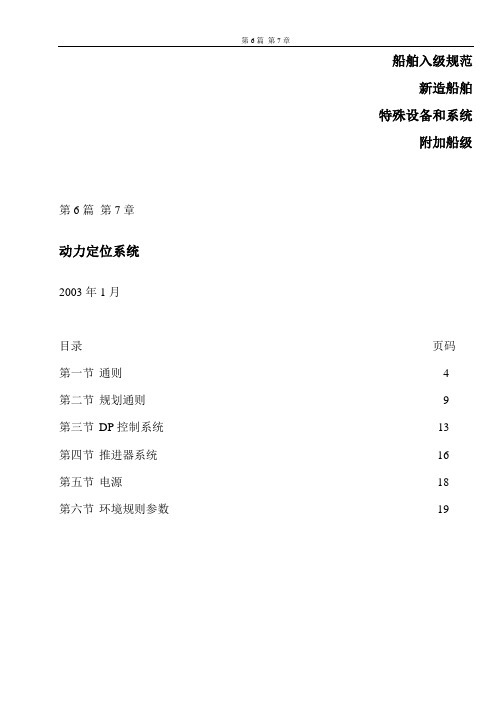
第6篇第7章船舶入级规范新造船舶特殊设备和系统附加船级第6篇第7章动力定位系统2003年1月目录页码第一节通则 4第二节规划通则9第三节DP控制系统13第四节推进器系统16第五节电源18第六节环境规则参数19规范更改说明综述本章为上一版本的重版,也包含一些在2002年7月版本的第0部分第1章第3节列出的修改和勘误,除此之外,没有别的修改。
本章在被新的修订版替换之前有效,改版前对规范所作的少量修正和勘误,仅列表刊载在第0部分第1章第3节中,不会发行新的副刊。
第0部分第1章通常于每年1月及7月修订。
修正过的各章将发给本规范的所有订户,建议再版本的购买者核对刊印在第0篇第1章第1节规范各章的最新目录,以确认该章为现行版本。
目录第1节通则 4A.规则 4 A 100 范围 4 A 200 入级符号 4A 300 环境入级参数 4B. 定义 4 B 100 通则 4 C.证书 5 C 100 通则 5 D.送审文件 5 D 100 通则 5 D 200 ern计算 5 D 300 仪表与自动化 5 D 400 推进器文本 5 D 500 电源系统文本 5 D 600 故障模式响应分析(FMEA) 6 D 700 操作手册 7 D 800 试验和海试程序 7 E.完整的DP系统测试 7 E 70 通则 7 E 200 测量系统 7 E 300 推进器 7 E 400 电源 7 E 500 联合操纵 7 E 600 完整的DP系统测试 8 E 700 DYNPOS-AUTR和DYNPOS-AUTRO的冗余测试8 F.变更8 F 100 船东义务 8第2节规划通则9 A. 通则9A 100 通则 9B. 冗余和故障模式9 B 100 通则9 B 200 冗余9 B 300 故障模式9 B 400 独立性9B 500 对DYNPOS-AUTRO的一般要求10C. 系统规划10 C 100 通则10 C 200 DP控制中心 11 C 300 位置控制系统的规划 11 C 400 控制面板的规划和布置 11C 500 数据通讯链的规划与布置 12D. 内部通讯 12 D 100 通则 12 第3节 DP控制系统13A. 通用要求13A 100 通则13B. 系统规划13B 100 操纵杆推进器控制13B 200 推进器控制模式选择13C. 位置参照系统13C 100 通则13D. 传感器14D 100 通则14F. 监测14F 100 通则14F 200 因果分析15第4节推进器系统16A. 通则16A 100 适用范围16A 200 推进器配置16A 300 推进器控制16A 400 指示16第5节电源17A. 通则17A 100 通则17A 200 发电机的容量和数量17A 300 电源管理(对DYNPOS-AUTR和DYNPOS-AUTRO)17A 400 主配电板和分配电板的规划17B. 控制系统电源18B 100 通则18B 200 软件制造18C. 辅助系统(对DYNPOS-AUTR和DYNPOS-AUTRO)18C 100 通则18C 200 燃油18C 300 冷却水18第6节环境规则参数 19A. 内容描述19A 100 通则19第1节通则A规则A100范围101本节中的规范要求适用于船舶或移动海上平台(后称舰船)的动力定位系统。
概述海上钻井平台的动力定位系统

概述海上钻井平台的动力定位系统动力定位(Dynamic Positioning)系统已经广泛应用于海洋作业船、海洋科考船、深海半潜式钻井平台以及为钻井平台服务的穿梭油轮、储油加工等船舶,目前建造的海洋工程船如风车安装船、穿梭油轮、MPF1000FDPSO和半潜式钻井平台如Sevan650、GM4000等都装备了动力定位系统,这些船根据用途装备的动力定位设备等级不同,因此设备的配置和入级标志也不同,下面作个简单的介绍。
1 动力定位功能及系统组成1.1 动力定位功能动力定位(以下简称DP)是完全依靠推进力方式而不是锚泊方式保持船位(固定位置或预定航线)。
其基本工作原理是利用计算机对接收的卫星定位信号(DGPS)、环境参数(风、浪、流)以及船舶传感器输入的船舶位置信号,自动地与计算机中模拟的预定船位进行比较,推算出保持这一位置需要的各推进器的推力、速度和方向,自动控制推进器工作。
反复地进行比较判断计算和执行控制,使船舶在规定的环境条件下,位置保持在精度允许的范围内。
1.2 DP系统组成DP主要有3大系统组成:电力系统;控制系统;推进系统。
1.2.1 DP电力系统:发电机组;配电系统;功率管理系统。
1.2.2 DP控制系统:计算机及自动控制系统;独立操纵杆系统(手动控制);传感器系统[电罗经、移动参照传感器(MRU)、风向风速传感器];位置参照系统[卫星参照系统GPS、激光参照系统(Laser)、雷达参照系统、无线电参照系统、水声参照系统、张紧索参照系统(Tautwire)]。
2 DP设备等级国际海事组织(IMO)通过的《海上移动式钻井平台构造和设备规则1989修正案》中详细地规定了DP设备等级,其文Msc./Cire.645《采用动力定位系统船舶导则》中规定了DP系统的设备等级分别为3级,即:Class1、Class2、Class3(为叙述方便,本文用DP1、DP2、DP3代表3个动力定位设备等级)。
第四篇第8章 中文 DNV规范
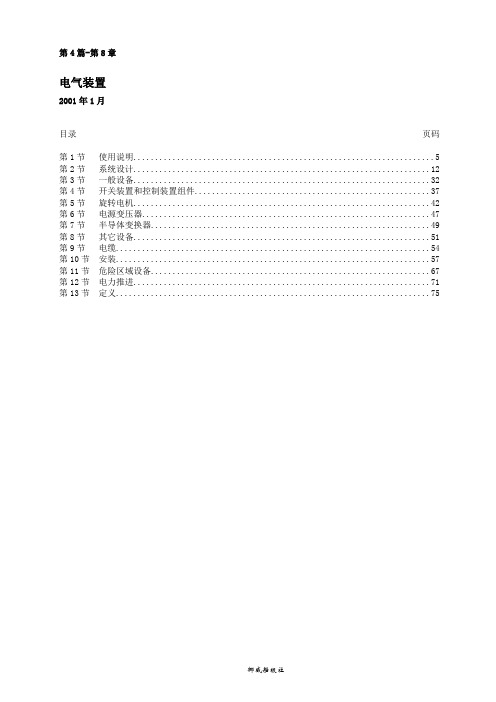
第4篇-第8章电气装置2001年1月目录页码第1节使用说明 (5)第2节系统设计 (12)第3节一般设备 (32)第4节开关装置和控制装置组件 (37)第5节旋转电机 (42)第6节电源变压器 (47)第7节半导体变换器 (49)第8节其它设备 (51)第9节电缆 (54)第10节安装 (57)第11节危险区域设备 (67)第12节电力推进 (71)第13节定义 (75)规范更改说明综述理事会于2000年12月和2001年6月确定了包括增补和修订在内的先行规范版本,并以此更换1998年1月版船舶入级规范的第4篇第4章和1996年1月版HS、LC和NSC入级规范第4篇第4章.本章规范的更改于2002年1月1日生效.本章在被新的修订版替换之前有效.改版前对规范所作的少量修改和勘误,仅列表在第0篇第1章第3节中,不发增刊.第0篇第3节通常于每年1月和7月修订.修改过的各章将发给本规范的所有订户.建议再版本的购买者核对刊印在第0篇第1章第1节的规范各章的最新目录,以确认该章为先行版本。
主要更改本章已被完全重写.其技术要求已同国际标准的发展一致.更改包括:-已加入了应急发电机的保护要求,包括当应急发电机起动失败时需有一个报警.-关于断路器短路容量要求的术语和澄清已更新. -当LV组件为型式试验或部分型式试验时缩减电气间隙和漏电距离可接受.-强制冷却式变压器现在可被接受.-对于5级导体的附加要求已于IEC一致.-禁止一般性电缆在接线盒的编接已被删除.-关于电缆外护套所剥去长度已被删除.-已增加了同IEC一致的关于危险区域设备的新的章节.关于DNV工作程序的正式要求已含在第1节中,且已形成了完整的审核表,也就是电气系统认可,电气设备证书(认可和产品检查)和现场检查.电气系统的技术要求已经从设备和部件的要求中单独列出.关于何时要求产品证书的限值已被更正.对于中型机器和变压器,型式认可证书连同工作认可证书可替代NV产品证书.已含电气配电系统型式认可可能性的介绍.已执行了送审文件的新的要求.目录第1节使用说明 (5)A.适用范围 (5)A 100 总述 (5)B.审核方案 (5)B 100 总述 (5)B 200 系统设计 (5)B 300 设备认证 (7)B 400 现场检查 (10)第2节系统设计 (12)A.供电系统 (12)A 100 综述 (12)A 200 系统电压和频率 (13)B.主要供电系统 (14)B 100 综述 (14)C.应急电源系统 (15)C 100 应急电源和配电 (15)C 200 临时电源 (17)C 300 应急发电机 (18)D.蓄电池装置 (18)D 100 综述 (18)E.发电机原动机 (19)E 100 综述 (19)F.配电 (19)F 100 配电通 (19)F 200 照明 (20)F 300 岸电连接 (20)G.保护 (21)G 100 系统保护 (21)G 200 电路保护 (21)G 300 发电机保护 (22)G 400 变压器保护 (23)G 500 电机保护 (23)H.控制 (23)H 100 系统控制 (23)H 200 电机控制 (24)I.船舶布置 (25)I 100 综述 (25)I 200 旋转电机,一般要求 (26)I 300 蓄电池装置 (26)I 400 电缆走线 (27)I 500 防雷保护 (28)J.电缆选择 (28)J 100 综述 (28)J 200 电缆温度 (28)J 300 绝缘材料的选择 (28)J 400 电流定额 (29)J 500 修正系数 (29)J 600 电缆的并联连接 (30)J 700 A.C装置和特殊D.C装置的附加要求 (31)J 800 电缆的定额.........................31 第3节一般设备 (32)A.总体要求 (32)A 100 参考 (32)B.环境要求 (32)B 100 倾斜 (32)B 200 振动和加速度 (32)B 300 温度和湿度 (32)C.设备定额 (33)C 100 电气参数 (33)C 200 最大操作温度 (33)D.机械和电气特性 (33)D 100 机械强度 (33)D 200 冷却和防冷凝 (34)D 300 接线端和电缆进线 (34)D 400 设备保护性接地 (34)D 500 外壳入口保护 (35)D 600 电气间隙和爬电距离 (35)E.标识和告示牌 (36)E 100 一般要求 (36)F.绝缘 (36)F 100 绝缘材料 (36)第4节开关装置和控制装置组件 (37)A.构造 (37)A 100 综述 (37)B.电力电路 (38)B 100 组件中的电力器件 (38)B 200 蓄电池 (39)B 300 高压组件的附加要求 (39)C.控制和保护电路 (39)C 100 控制和仪表 (39)D.审核和试验 (40)D 100 一般要求 (40)第5节旋转电机 (42)A.一般要求 (42)A 100 参考 (42)A 200 发电机和电动机的一般要求 (42)A 300 电机仪表 (43)B.对发电机的附加要求 (43)B 100 综述 (43)B 200 电压和频率调节 (43)B 300 发电机短路能力 (44)B 400 并联操作 (44)C.审核和试验 (44)C 100 工厂试验 (44)第6节电源变压器 (47)A.总述 (47)A 100 一般要求 (47)A 200 电源变压器的设计要求 (47)B 检查和试验 (47)B 100 综述 (47)第7节半导体变换器 (49)A.一般要求 (49)A 100 总述 (49)A 200 机械要求 (49)A 300 半导体组件的电气设计要求 (49)B.试验 (49)B 100 试验 (49)第8节其它设备 (51)A.一般要求 (51)A 100 蓄电池盒和锁柜 (51)A 200 插座和插头 (51)A 300 照明设备 (51)A 400 加热设备 (51)A 500 炊具和其它厨房设备 (52)第9节电缆 (54)A.适用范围 (54)A 100 总述 (54)B.一般性电缆构造 (54)B 100 总述 (54)C.高压电缆 (54)C. 10O 总述 (54)D.低压电力电缆 (55)D 100 0.6/1kV和1.8/3kV电缆 (55)D 200 防护外套 (55)D 300 金属丝编织和铠装 (56)D 400 配电板布线 (56)D 500 轻型电缆 (56)E.控制电缆 (56)E 100 构造 (56)F.仪表和通讯电缆 (56)F 100 总述 (56)第10节安装 (57)A.一般要求 (57)A 100 总述 (57)B.设备 (57)B 100 设备位置和布置 (57)B 20O 设备外壳、入口保护 (57)B 300 蓄电池 (59)B 400 设备的保护性接地和连接 (59)B 500 设备接线、断开、标识 (59)C.电缆 (60)C 100 总述 (60)C 2OO 电缆走线 (60)C 300 舱壁和甲板的贯穿 (61)C 400 防火措施 (61)C 500 电缆及电缆走线的支撑和固定 (62)C 600 电缆膨胀...........................63 C 700 电缆管.. (63)C 800 电缆的编结 (64)C 900 电缆端子 (64)C 1000 电伴热或表面加热装置的要求 (65)D.检验和试验 (65)D 100 总述 (65)D 200 设备安装 (65)D 300 接线和接地 (65)D 4OO 配电系统性能 (65)第11节危险区域设备 (67)A.综述 (67)A 100 通则 (67)B.送审文件 (67)B 100 总述 (67)C.设备选择 (67)C 100 一般要求 (67)C 200 按范围之Ex保护 (67)C 300 对于设备和电路设计的附加要求 (68)D.安装要求 (68)D 1OO 一般要求 (69)D 200 布线和端子 (71)第12节电力推进 (71)A.总述 (71)A 100 总述 (71)A 2OO 系统设计 (71)A 300 系统容量 (71)A 400 供电系统 (71)A 500 系统保护 (71)A 600 控制系统 (72)B.扭转振动 (73)B 100 总述 (73)B 200 振动测量 (73)B 300 稳态-扭转振动 (73)B 400 瞬态扭转振动 (73)C.检验 (73)C 100 工厂试验或制造厂试验 (73)第13节定义 (75)A.定义 (75)A 100 总述 (75)A 200 操作条件 (75)A 300 设备 (75)A 400 安装 (76)A 500 区域定义 (76)A 600 危险区域 (76)A 700 电源、发电站、配电 (77)A 800 配电板定义 (77)A 900 部件和相关解释 (77)第1节使用说明A.适用范围A 100 总述101目的a) 本章规范适用于主船级分配的电气设备.b) 本规范列出了所有电气设备对于人身安全和失火危险的要求.c) 本规范对所有服务于必需和重要设备之电气装置的有效性提出了要求.d) 本规范对设备证书提出了要求,见B303.e) 电力总容量小于10OkVA的装置,对于这种装置本社可对技术要求和审核程序考虑变通的要求变通要求应同各种情况一致并应基于以下信息: -适当的船级符号-操作性-系统设计的一般信息.变通要求的信息应对操作状态有效.f) 入级范围不含可携式电气器件.102增补要求对具有附加船级符号的船舶,将依据本规范相关部分的要求提出增补的要求103 IEC标准a) 本章的要求通常是基于IEC(国际电工委员会)为船舶和近海装置所发行的适用性标准.b) 在这些标准直接引用处,标准在入级要求时间生效.c) 若标准在入级要求日期前6个月内被替换,则先前的版本有效.指导性意见:此处主要指IEC60092船舶部分和IEC61892(1到7)近海装置部分.-指导性意见结束-104其它标准a) 若本社发现有于本规范中标准有同等完全安全含义者,则将考虑可选择标准的使用.b) 不经船厂、业主或操作者的同意,其它标准的使用也可得到认可.并提交其它标准认可的适用范围.对以上要求,将提供标准的英文版的拷贝. 105 可选择方案a) 若本社发现其有同本规范方案要求的安全性和有效性具有同水平者,则对应于本规范要求的可选则方案可接受.此认可可不经船厂、业主、操作者的同意.b) 当使用可选择方案时,可能需要对本规范所要求部分进行附加审核.指导性意见:当在同一系统中使用不同标准时,其要求应要特别的注意.B.审核方案B 100总述101工作步骤a) 作为船级授权的基础,本社将对电气装置审核其是否同相关标准一致.此审核步骤如下:-系统设计认可(200)-设备证书(300)-现场检查(400)b) 审核程序的执行应以现场检查为基础.并对船厂和其它合同范围内的人士负有适用规范一致的全部责任.c) 规范包括的标准设计的认可如下:-系统(包括分配系统)-设备-部件型式认可表中包括了标准设计和相关认可的评估.102 图纸认可a) 设计的认可应以相关信息要素的评估为基础.b) 应按203和302的要求对评估提交信息要素.表格分两栏“规范审核参考”、“目的”.-“规范审核参考”:列出规范相关部分的参考,指明审核程序的范围.-“目的”:指明文件是否将认可,或仅用于信息,或用于本社以上要求.c) 标有可用的要素是考虑到设计的需要并为责任人员所准备.除非本社有特殊要求,将不作为评估.-若本社发现有必要,将在本规范中列出所要求的附加信息.B 200 系统设计201总述电气系统的评估应以202和203所要求的信息为基础.202系统原理若“全船单线图”不足以列出操作的必要理解和相关操作模式时,应提交给船舶“系统原理”或全船电气说明.a) 以下类型的船舶通常应提交“系统原理”:-高速、轻艇及海军轻艇-近海移动装置-钻探船舶-运油及储油装置(或相关装置)-满负荷船舶-客船-电力推进船舶b) “系统原理”应包括以下(相关)信息:- 所有操作模式的系统构造、不同船舶系统或设施(必需、重要和应急设备)的配电原理.动和停止电源等)- 在相关失效模式下的系统动作. -瘫船恢复设置.B 300设备认证301总述a) 303 所要求认可的电气设备应由302的说明来认证. b) 应在201所提出的设计评估和304所规定的产品检查的基础上进行设备认证.302 应提交的设备信息303所要求的认证a) 服务于必需或重要功能的电气设备和电力应按e)的要求带证书交付.b) 本规范的其它相关部分列出了认证的附加c) 含有效型式认可认证的设备通常不需要进一步的设计审核或产品检查即可被接受,除非证书有其它规定.型式认可证书的拷贝应替代DNV设计评估所要求d) 可发行基于型式认可证书和产品检查的产品证书,型式认可证书规定的除外.e) 表B7 列出了所要求的证书.a) 作为认证过程的一部分,应进行产品检查.检查通常包括:-制造商送审文件复审-直观检查-试验b) 直观检查应审核以下:-制造和安装是否同302规定的认可设计信息一致.-产品制造是否同本规范相关设备章节的要求一致.-一般性工艺是否可接受c) 制造商试验的拓展应按本规范适用章节的规定.在302要求处试验的进行应于认可的试验程序一致.试验的结果应记录并归档.指导性意见:对于直观检查(通常应强调条目的一般性说明)和制造检查的指导性意见可在DNV认证标准里找到.B 400 现场检查401总述船上的安装应达到整个电气系统和部分系统的功能. 402现场检查为评估以下项目,应进行现场检查:-电气装置是否同接受的或认可的信息一致.-电气装置是否同本规范要求一致.-工艺是否可接受.403功能试验a) 功能试验是本社审核装置是否于规范要求一致的一部分.规范所要求试验的执行应能证明以下:-电气系统功能同认可的信息一致-电气系统功能同规范要求一致.b) 码头和海试的记录应提交给本社以归档在“作为实施”的文本中.404可利用的文件在现场检查时,以下文件对于本社检查员有用:-认可的设计文件和提交给302所要求信息的文件-要求认证设备的DNV认可-认可区域入级图和相关位置的ESD原理-认可的Ex证书-认为评估相关装置是否同规范一致所需要的附加文件.第2节系统设计A.供电系统A 100 综述101一般要求a) 电气装置应确保乘客、船员的安全,以避免电气危害.b) 船上应有两套相互独立的、独自供电的系统:-主供电系统-应急供电系统,e)和C101规定的除外.c) 在火灾、洪水或其它危险条件下,含有电力供电电源的场所不应使电源、主配电板相关设备和变压器失效.d) 在火灾、洪水或其它危险条件下,任何其它不含c) 所规定的场所不应使供电电源或主配电板相关设备失效(不应使遥控操作削弱).也不应使多于一个的照明系统失效(主要或应急照明系统).e) 对于没有配备应急供电系统的船舶,按C104的要求可被接受.指导性意见:关于应急电源和应急配电板位置的要求见C101.附加船级符号可能会影响到供电系统的布置.指导性意见结束102环境条件a) 电气装置通常应适宜在第3节B列出的环境条件下操作,并应有按第10节B200列出的入口防护额定值.b) 若使用了某种方式来控制环境条件,则装置可设计为a)要求外的此中控制方式在装置服务区域内设置的冗余时间.c) 气体危险区域内的电气装置应满足第11节的要求和本规范相关章节的其它特殊要求.指导性意见:对于通风和空调的要求见1101.指导性意见结束103系统接地a) 若系统中性点接地,应使用分离手段使系统接地切断,以便进行维修或绝缘电阻测量.b) 在中性点接地系统中,接地中性点的平均电流不允许超过所连发电机或变压器额定电流的20%.c) 在4线配电系统中,系统中性点应永久接地,不得使用接触器.d) 系统接地应使用独立的非载流部件接地布置方式.e) 变压器主边中性点不应在发电机中性接地系统中接地.104配电系统的类型a) A.C电源:应使用以下配电系统(例外见105、106):-高阻中性点接地的3相3线系统-低阻中性点接地的3相3线系统-中性点直接接地的3相3线系统-中性点绝缘的3相3线系统b) 另外对于电压达到(含)500V A.C的系统:- 3相4线中性点接地系统,但不带船体回路(TN-S-系统). 在从配电板开始至变压器负边结束的变压器和N-汇流排之间可使用PE(保护性接地)和N(系统接地),也就是TN-C-S-系统.-中性点绝缘的单相2线系统-单相2线并在电源端1相接地的不带c) D.C.电源: 应使用以下配电系统(例外见105、106):- 2线绝缘系统-在电源端单极接地的2线系统(无船体回路)-单线并带船体回路的系统,105中的可接受. 105 船体回路系统a) 对于任何其它船舶,船体回路分配系统不应用于液货船上,或用于电源、加热、照明.b) 若任何其可能产生的电流不直接流经气体危险区域,则105的要求不排除以下用途:-外加电流阴极保护系统-有限和局部接地系统-所提供的计算电流在最严峻条件下不超过30mA 的绝缘等级监测系统.c) 若使用船体回路,则所有最终辅助电流,也就是在最后保护装置后的所有电流,应为2线且应有特殊的预防措施.106液货船系统a) 通常,不应在液货船内使用接地配电系统.106的要求不排除使用本质安全接地电路.b) 在旗国法定检验认可的条件下,可使用以下接地系统之一:-所供电源、控制电路和测量电路,若由于技术或安全原因而不使用不接地系统,只要正常和故障条件下其在船体的电流限值在5A以内.-有限和局部接地系统,只要任何其可能产生的电流不直接流经任何危险区域.- 1000V均方根(线间)及以上的A.C供电网络,只要其任何可能产生的电流不直接流过任何危险区域.107 对于非金属船舶的特殊要求a)非金属船舶的所有金属部件应连为一体,并尽可能的要考虑到相异金属之间的电流腐蚀,以形成一个连续的电气系统用于电气设备的接地回路并在水浸时时船舶连于水.结构内部绝缘部件的联合通常不必要,燃油舱除外.b) 应对每一压力注油点使用联合加油设备至船舶.c) 对于由于液体或气体的流动而能产生静电放电的金属性导管应连为一体,以便使其全部长度均为电力连续且应适当接地.d) 用于平衡静电放电的辅助导体、设备结点等(但不应用于传送闪电泄电),其最小截面积应为5mm2或在铝中应有同等冲击电流传送能力. e) 在所联结物体和基本结构间的电气阻值应不超过0.05 欧姆,在可证明的更高的阻值不引起危险处可除外.所连接的通道应有足够的截面积以传送最大的电流(像强加于其上的过量的电压降).f) 应在船上一适宜地方限定和安装一主接地排.此接地排应连于船体上一最小面积为0.2m2的铜板,并使其在所有船倾条件下处于浸入的位置.A 200 系统电压和频率201 综述a) 电气配电系统应在202到207列出的电压和频率范围内操作.此点同样适用于一个或一个以上的发电机原动机驱动其它设备的配电系统.当主推进电机用于发电机原动机时,由波动或忽然调节(含忽然停止)不应超过所列出的限值.b) 若有据实际变化而有意的设计,则系统或部分系统可允许以上有电压变化的偏离.c) 除说明外所有提到的电压为均方根.202 最大系统电压a) 除b)中说明外,配电系统中以下最大电压适用:-永久配线连接:15000V-对于使用软电缆连接(其使用时不为手持)的便携式器件和插座:1000V-对于照明(含信号灯)、居住处所的空间加热器、插座、手持式便携器件和对于控制、通讯、测量设备的供电:250V.b) 对于高速、Light Craft 和 Naval SurfaceCraft,最大配电电压应限值在500 V,电力推进系统除外,其可有更高的电压. 203最大控制电压对于作为电力和加热装置一部分的控制设备(例如用于电机起动和停止的压力或温度开关),其最大电压为1000V.但,对于外部设备的控制电压不应超过500V.204供电电压变化a) 设计和安装的电力配电系统应使其在主配电板上的电压变化维持在以下限定内:备用状态-额定A.C电压的±2.5%-蓄电池装置额定D.C系统电压的±12%.瞬时状态-额定A.C电压的-15%到+20%-额定D.C蓄电池电压的±25%b) 最大瞬态电压的要求同样应适用于负荷脱离或负载脱扣和故障条件下.c) 瞬态条件发生后,A.C主配电系统的电压应在1.5s内恢复到额定系统电压,偏差不超过±3%.应急配电系统中电压应在5s内恢复到额定系统电压,偏差不超过±3%.205配电系统的电压降a) 设计和安装的A.C配电系统应使其到单独负载的固定电压降(从主配电板到负载末端测量)不超过系统额定电压的10%.b) 设计和安装的A D.C配电系统应使其到单独负载的固定电压降(从蓄电池配电到负载终端测量)不超过系统额定电压的10%.c) 在此,不列出负载终端起动或停止时的瞬态电压要求. 但,设计的系统应能满足所有负载的功能. 206系统频率a) 有固定额定频率的A.C装置其频率变化应保持在以下限定内:-备用负荷条件下,额定频率的95到105%-瞬态负荷条件下,额定频率的90到110%.b) 对于为可变的系统频率、所有设备和可变频率的保护而设计的A.C装置,应使其在设计限值的全部频率幅度上正常操作.指导性意见:关于原动机速度调节器特性见第3章.关于测量设备见第9章第5节 B202.指导性意见结束207谐波畸变a) 产生瞬态电压、频率、电流变化的设备应不引起船上其它设备故障,也不应引起传导、感应或辐射.b) 在配电系统中电压波形的总谐波畸变不应超过5%,单相谐波不应超过3%.c) 若有文件可证明加速畸变级别的所有负载和配电设备可承受实际的水平,则总谐波畸变可超过b)列出的数值.d) 若使用了用于限值谐波畸变的滤波器,则应采取特殊的预防措施以使负荷脱离或负载脱扣,或变换器复位,且不应使其系统瞬态畸变超过204的规定.发电机应在其设计的能承受负荷限定范围内操作.配电系统应在其设计限定内和部分过滤器脱离或系统更改设定时,可操作.指导性意见:c)项要求的文件可考虑以下影响:-机器、变压器、开关装置和控制装置线圈的额外热损失-电容器的额外热损失,例如补偿荧光照明-供电网络所有引起的谐振-畸变仪表和控制系统的机能-测量仪表和保护装置(继电器)的精度畸变-各种电子设备的干涉,如:调节器、通讯和控制系统、位置探测系统、雷达和航行系统.对于系统责任的声明或保证可规定可接受的文件等级.指导性意见结束B.主要供电系统:B 100 综述101容量a)主电源系统应有向维持船舶正常操作所必需设施供电的能力,不含向应急电源所供电源.b) 主供电系统的主电源、变压器和电源变换器应有部件冗余以便在变压器或电源变换器失效时,供电系统有向以下设备供电的能力:-对推进和安全提供正常操作条件的必需设备-起动船上必需或重要的大型电机,侧推除外,且其瞬态电压和频率变化不会超过A200规定的限定范围.-确保最低舒适的可居住条件,其至少应包括烹饪、取暖、家用冰箱(空调制冷机除外)、机械通风、卫生水和淡水的充足使用.-对于双套的必需或重要辅助设备,如其一套为非电力而另一套为电力(如1号滑油泵由主机驱动,2号由电机驱动),当一发电机不工作时,其电力驱动辅助设备可不使用.-另外,对于发电机装置,应确保当任一发电机、变压器或电源变换器失效时,保持发电机装置或变压器有能力从瘫船条件下向必需的电气设备供电以起动主推装置.若其单独或同其它电力电源一起足以同时对C103要求供电的设备供电,则电力应急电源可用于瘫船条件的起动.指导性意见:推进和安全的正常操作条件所必需的设备一般不包括以下设备:-侧推,其不作为主推或操舵的一部分-绞盘-锚链-货物处理装置-空调冷却器但,由船级符号所要求的额外设备应列为重要设备.关于非重要负荷,应考虑所有发电机的容量.指导性意见结束102系统冗余a) 任何单个电路或汇流排的失效不应危及用于船舶操纵的必需设备.任何单个电路的失效不应使重要设备长时间不工作.任一单一的失效不应使服务于必需或重要设备的双套受电器失效.b) 若次级配电被设置为2个单独的系统且每一系统从1个变压器或变换器馈电,可能的双套必需或重要受电器应在2个系统中分配.c) 101提到的每一变压器均应用单独的外壳作为独立的装置安装.指导性意见:单一失效指在任何单独电路、馈电、变压器或配电板一个母排段的失效.指导性意见结束103三单芯变压器a) 三单芯变压器可替代一3相变压器.b) 三单芯变压器的安装应在以下方面考虑对2个3相变压器的均衡:三单芯变压器应用单独的外壳各自独立的安装,应有单独的开关装置和保护并单独布线.2个三单芯变压器的容量应同101一致.指导性意见:三单芯变压器可用同样的外壳安装,但每一相或芯间应使用阻燃隔离壁.指导性意见结束104配电系统的控制a) 配电系统的控制系统不应布置为单个电路或其部件的失效可导致更多的控制部分不工作.b) 其布置应使得单个的失效不危及船舶操作必需得双套必需设备,并不可导致双套的重要设备长时间不工作.c) 若配电系统配置了遥控操作,则就地操作方式应安装断路器.就地操作应同遥控系统有独立的功能.d) 对于控制系统的供电要求见F104.指导性意见:a)配电系统某一部分的控制系统失效应不导致配电系统其它部分失效,例如一个发电机断路器的故障不应使其它的发电机断路器失效,同样对于双套的变压器馈电.指导性意见结束105电源恢复若电源对于船舶的推进和操舵是必需的,系统应布置为对推进和操舵所必需设备的供电,以保证船舶安全,一旦任一发电机失效,应能维持或立即恢复.此指:-在海上,正常负荷需要多于一个的发电装置,则对供电系统,应提供方法以脱离或使受电器负荷削减,且可自动起动备用发电机并自动接通主配电板.若推进和操舵需要,则可脱离重要受电器以确保安全.若在线的发电机维持不了推进和操舵和船舶安全,则应采取措施以自动起动备用发电机并自动接通主配电板,同时自动重新起动必需的辅助设备.备用发电机应在失电后30s内接通主配电板.-若使用一台发电机向电源正常供电,应采取措。
[冗余,动力,系统]DP―3动力定位冗余系统设计与分析
![[冗余,动力,系统]DP―3动力定位冗余系统设计与分析](https://img.taocdn.com/s3/m/e039b9d9ba1aa8114531d9c7.png)
DP―3动力定位冗余系统设计与分析摘要:介绍国际海事组织对DP-3动力定位冗余系统的基本要求,分析目前主流的设计与系统布置上的要求。
通过实际的工程实例,对比分析两种不同的设计思路以及两种冗余系统FMEA的接受标准,可作为工程设计的参考。
关键词:动力定位;冗余;DP-3随着海洋钻探从浅海向深水及超深水区域发展,传统的锚泊定位系统锚链长度和强度都要增加,进而船舶重量增加,钻井甲板上的可变载荷减小,设备布置困难等缺点随之出现。
同时,锚泊定位系统也有自身的缺点,其较低的弹性和流体动力阻尼等使船舶一直暴露在风浪流的影响下,操作性和安全性都受到影响。
因此,发展高性能的动力定位系统(Dynamic Positioning System)成为深水海洋钻探的趋势。
自上个世纪60年代起,伴随着北海区域以及墨西哥湾海上油气田的开发,几大船级社、当地行业组织以及国际行业协会等对动力定位系统规范进行了大量的研究,并出台了众多的规范。
1994年国际海事组织出台了MSC Circ.645《GUIDELINES FOR VESSELS WITH DYNAMIC POSITIONING SYSTEMS》作为目前对动力定位系统的一个统一的法定要求。
随后,以DNV、ABS、LR、CCS等船级社为代表,以MSC Circ.645为基本准则,相继发展了自己的最新规范。
1.DP-3动力定位系统冗余理念的发展虽然从20世纪早期已经有很多国外公司研究生产船舶、海洋平台的动力定位系统,但是从真正意义上的自动动力定位系统起源于1961年,当时采用了四点系泊加四台手动可调螺旋桨,另外艏艉各配备一台360度全回转推进器,1971年自动动力定位系统第一次应用于航海钻井。
随着技术的发展,1980年,全球卫星定位系统(GPS)被引入,大大提升了系统的定位精度。
直到现在,DP-3动力定位系统的设计与物理双冗余的高冗余度概念以及闭环电网技术的采用,大大提升了系统的可靠性,并且降低了系统能耗。
大洋一号_科学考察船动力定位系统的设计

“大洋一号”科学考察船动力定位系统的设计何崇德研究员中国船舶重工集团公司第七〇一研究所上海分部[201102]摘要船舶动力定位系统的应用近年在国外发展迅猛,在国内也引起了愈来愈多的关注。
我国的“大洋一号”船于2002年增设了动力定位系统,成为达到国际先进水平的现代化远洋科学考察船。
本文介绍了该船动力定位系统的设计要点,对于国内船舶动力定位系统的应用与发展有一定借鉴意义。
关键词船舶科学考察船船舶设计动力定位中图分类号U 675.9年第卷第期!概述“大洋一号”船是我国唯一的一艘专门从事国际海底区域资源勘查研究开发的远洋科学考察船。
该船于2002年进行了高起点的增改装工程,大大提高了全船的技术水平,成为达到国际先进水平的现代化综合性科学考察船。
增改装工程中最重要的内容之一便是增设动力定位系统,以满足科学调查作业的需要。
作为国内第一艘自行设计增设动力定位系统的大型特种船舶,该船动力定位系统经历了论证、设计、调试与试验,成功地达到了预定目标,技术指标超过了预定要求。
本文介绍了该系统设计要点,以供国内同行参考。
"实船动力定位系统方案1.1“大洋一号”船增设动力定位系统的要求“大洋一号”船为双柴油主机带轴带发电机、单轴、单调距桨、单舵的钢质船舶。
其主要参数如下:船长104.5m 型宽16.0m 型深10.2m 满载排水量!5500t吃水!5.8m该船的主要任务是在北太平洋进行国际海底区域资源勘察研究与开发,能搭载水下遥控潜器ROV 与水下自主机器人AUV 。
此船增设动力定位系统的要求是船舶能定点控位以便进行海底地层钻探等海底作业,并能实现ROV 跟踪以及循迹航行以便进行走航式探测。
1.2定位能力的确定船舶动力定位能力应根据该船任务需要以及作业海域条件来决定。
根据统计资料,“大洋一号”船主要作业海域的海流0!1.0kn 出现概率为86.8%,风力小于或等于7级的概率为98%。
因此将动力定位系统的定位能力确定为能抵抗1.0kn 海流、7级风较为合理。
DP system

给定的最严峻环境条件给定的最严峻环境条件系指船舶作业区域内的最大风速﹑流速与浪高。
根据不同工况要求和操作要求,调整DP等级,以降低能耗和对周边环境的影响。
主要DP控制系统供应商“绿色DP” 控制系统控制器全回转推进器硬线或网络侧推推进用推进器一般的位置测量设备•扇形波束测位仪(激光技术)Fan Beam (Laser Technique)•张紧索(测垂向倾角);Taut Wire (Vertical Angle)•差分式全球卫星定位系统DGPS (借助卫星)•水下声学定位系统HPR (有长﹑短基线等方法,需水下声学应答器,水下声学技术);HPR(Long &Short Base, Hydro‐acoustic, Transponders)•Atriums (无线电波,需要岸上参考目标,适用于特定位置)Atriums (Radio Wave, Landmark, SpecificSite)•其他设备Others联合操纵杆零级定位DPS‐0适用于安装有动力定位系统的船舶,它具有集中手动位置控制和自动艏向控制,在给定的最严峻环境条件下,能保持船舶的位置和艏向。
For vessels which are fitted with a dynamicpositioning system with centralized manual positioncontrol and automatic heading control to maintain the position and heading under the specifiedmaximum environmental conditions.一个典型的DPS‐2系统内部构成A Typical DPS‐2 Configuration双操作站双控制器三级定位DPS‐3适用于安装有动力定位系统的船舶,在给定的最严峻环境条件下,包括发生任何单一故障(包括由于火灾或水灾而失去整个舱室),能自动保持船舶的位置和艏向在给定的运行范围内。
第四篇 第九节 中文 DNV规范
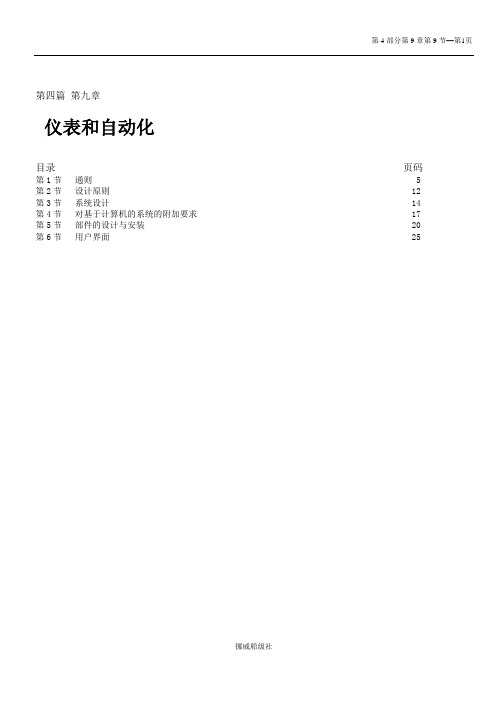
第四篇第九章仪表和自动化目录页码第1节通则 5 第2节设计原则 12 第3节系统设计 14 第4节对基于计算机的系统的附加要求 17 第5节部件的设计与安装 20 第6节用户界面 25规范的更改通则规范的这个版本包括2000年10月和2001年6月所作的增加与修改,它用来取代1999年1月版本中的相应规则。
本规范中所作的变更于2002年7月1日起强制执行本章在被更新的版本取代前均有效。
除了在每年1月与7月对第0篇第1章第3节给出的校核清单提到的修正与更新外,本社不会出版相关的增刊进行修改。
更新的章节,将会发送给所有的规范预定者。
建议单行本的购买者检查第0篇第1章第1节的更新章节清单,以确保其正确性。
主要的更改通则部分--提出了一个新的特定区域的电磁兼容性(辐射)等级的规定。
它规定了对舰桥、开敞甲板及其它特定区域的电磁辐射计算的不同的要求。
并且,它对提交的文件的要求作出了更改。
--以前版本中对移动海上平台的要求已经移至其它相关的章节中。
第一节一般规定部分--对C103、C104、C203、C204、C210、C214作出了内容上的修改,C213、C217已经删除,其它的小节已经重新编号。
--表C1与C2中增加了需提交MCR(遥控推进系统)的文本的要求。
--表C2中增加了需提供TVS(电视监视系统)的文本的要求。
--对D102与D503做出了修改。
--原来的C600编号改为C500。
第2节设计原则部分--对A205与C102的指导性意见作了修改。
--增加了一个新的D100小节,它是关于SOLARS REG.II-1/49.4和机器的就地控制第3节系统设计部分--对B205作了修改。
第4节对基于计算机的系统的附加要求部分--增加了A202小节,它是关于有电池做后备电源的RAM 与非可变存储器的部分。
--对A701小节的指导性意见作了扩展。
第5节部件的设计与安装--增加了表B1,它是关于EMC和表B2的修改。
DNV规范电气章节1

C.船级的中止和取消··············19
C 100 一般要求····················19 C 200 船级的中止··················19 C 300 船级的取消··················19 C 400 重新入级····················19
中。 ——在 B201 中,关于由国家主管机关检验的第二段
已删去。 ——在 B901 中,关于船级条件和备忘录的条文已删
去。 ——已加入新的关于新造船舶规范适用于营运中船
舶的 B1000。 ——关于证书的有效期和颁发的子节 C 已删去。 ——子节 D 已重新命名为子节 C。
勘误和澄清
除了上述的规范更改外,一些发现的错误已修正,还 对规范中的措词作了一些澄清。
第 3 节 入级程序··············14
A.船级的授予·····················14
A 100 入级申请····················14 A 200 对车间和船厂的要求··········14 A 300 对制造厂的要求··············14 A 400 对提供服务者的要求··········14
船舶入级规范 2002 第 1 篇第 1 章第 1 节 第 2 页
规范更改说明
综述
理事会 2002 年 6 月确定了包括修订和增补在内的现 行规范版本,并以此更换本章的 2002 年 1 月版。本 章规范的更改于 2002 年 7 月 1 日生效。
本章在被新的修订版替换之前有效。改版前对规范所 作的勘误,仅列表刊载在第 0 篇第 1 章第 3 节中,不 发增刊。第 0 篇第 1 章通常于每年 1 月及 7 月修订。
船舶动力定位系统的总体设计
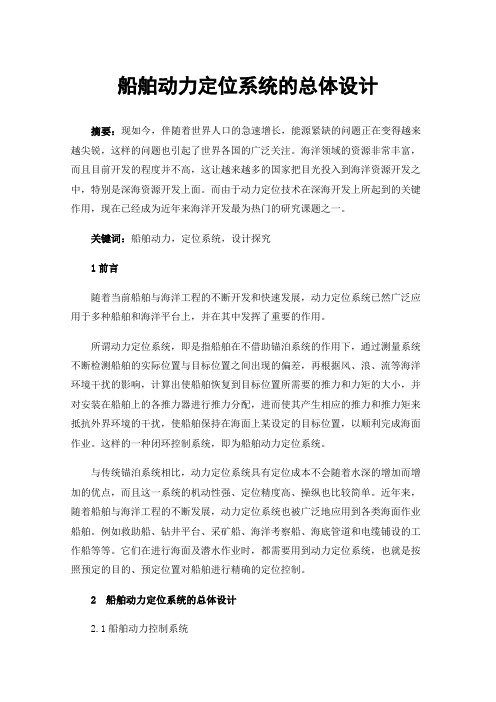
船舶动力定位系统的总体设计摘要:现如今,伴随着世界人口的急速增长,能源紧缺的问题正在变得越来越尖锐,这样的问题也引起了世界各国的广泛关注。
海洋领域的资源非常丰富,而且目前开发的程度并不高,这让越来越多的国家把目光投入到海洋资源开发之中,特别是深海资源开发上面。
而由于动力定位技术在深海开发上所起到的关键作用,现在已经成为近年来海洋开发最为热门的研究课题之一。
关键词:船舶动力,定位系统,设计探究1前言随着当前船舶与海洋工程的不断开发和快速发展,动力定位系统已然广泛应用于多种船舶和海洋平台上,并在其中发挥了重要的作用。
所谓动力定位系统,即是指船舶在不借助锚泊系统的作用下,通过测量系统不断检测船舶的实际位置与目标位置之间出现的偏差,再根据风、浪、流等海洋环境干扰的影响,计算出使船舶恢复到目标位置所需要的推力和力矩的大小,并对安装在船舶上的各推力器进行推力分配,进而使其产生相应的推力和推力矩来抵抗外界环境的干扰,使船舶保持在海面上某设定的目标位置,以顺利完成海面作业。
这样的一种闭环控制系统,即为船舶动力定位系统。
与传统锚泊系统相比,动力定位系统具有定位成本不会随着水深的增加而增加的优点,而且这一系统的机动性强、定位精度高、操纵也比较简单。
近年来,随着船舶与海洋工程的不断发展,动力定位系统也被广泛地应用到各类海面作业船舶。
例如救助船、钻井平台、采矿船、海洋考察船、海底管道和电缆铺设的工作船等等。
它们在进行海面及潜水作业时,都需要用到动力定位系统,也就是按照预定的目的、预定位置对船舶进行精确的定位控制。
2 船舶动力定位系统的总体设计2.1船舶动力控制系统控制系统:由自动控制系统和联合操纵杆控制系统(IJ)构成,包括带自动与手动控制功能相互热冗余的 DP-A/DP-B 操作站、带自动定向、手动控制功能的 IJ 操作站、DP-A 控制单元、DP-B 控制单元、IJ 控制单元、便携式控制面板、不间断电源(UPS)和报警打印机等等,详见图 1。
动力定位系统规范介绍_孙武

2 级设备
3 级设备
单个故障 , 可能出现 活动 部 件或 系统 单 个故 一舱失火或浸水情况下 ,
船位丢失
障情况下 , 会造成位置丢 不会造成位置丢失
失
图 1 动力 定位系统基本配置
4 设备的配备
动力定位系统由推力器 、计算机控制系统 、位置 参照系统 、动力系统等组成 。 典型的动力定位系统
成位置丢失
统)情 况下 , 自动 保 持船 不会造成位置丢失
位和艏向
DP-1
DP-2
DP-3
自动 保 持 船位 和 艏
向 , 还具有独立的集 中手 控 船 位和 自 动 艏向控制
单个故障(活动部件或系 统)情 况下 , 自动 保 持船 位和艏向
一舱失火或浸水情况下 , 自动保持船位和艏向
1 级 设备
动力定位系统首先在海洋钻井船 、平台支持船 、 级社(BV)也相继出版了动力定位规范 。 中国船级
潜水器支持船 、管道和电缆敷设船 、科学考察船和深 社(CCS)则于 2002 年正式出版了第一本动力定位
海救生船上得到了应用 , 其主要原理是利用计算机 规范 。
对采集来的环境参数(风 、浪 、流), 根据位置参照系 统提供的位置 , 自动地进行计算 , 控制各推力器的推
出版了动力定位系统规范 。为了指导船东正确地操 保留了手动或半自动动力定位系统的附加标志 。就
作动力定位系统船舶 , 英国能源部和挪威石油理事 目前动力定位技术发展水平而言 , 海上平台供应(支
会于 1983 年联合出版了《Guidelines f or the Specifi- 持 、守护)船 、电缆或管道敷设/检验船 、科学考察船
动保持船位
保持船位
和位置参考备用 , 自 度 , 自动保持船位
DNV定位系泊规范

systems without redundancy. — Item B600 "Refined response analysis" deleted (since
sultancy services. — Offshore Standards. Provide technical provisions and acceptance criteria for general use by the offshore industry as well as
the technical basis for DNV offshore services. — Recommended Practices. Provide proven technology and sound engineering practice as well as guidance for the higher level
• Ch.2 Sec.2
B. Method — Chain quality R5 included. — Description of 'time domain' and 'frequency domain' -
mooring analyses. — Guidance regarding duration and extreme value estima-
conditions included, such as West Africa. — Detailed description of how typical squall conditions shall
DNV规范

SECTION 8 制造、工艺和试验PT.4 CH.7 SEC.8A. 制造A 100 General 总则101I、II级压力容器应由船级社认可的工厂制造。
102焊接应由认可的工人,见PT.2 CH.3 SEC.3,根据认可的图纸和说明书进行。
对于I、II级压力容器的焊接工艺合格要求按PT.2 CH.3 SEC.3,或者按照公认标准。
B. 工艺B 100 板材切割101 板材一般采用火焰切割而不采用剪切加工,除非机加工去除的割边量为1/4的板厚,但最小为3mm.B 200 焊缝201对于纵缝和环缝主要对接焊缝仅认可全焊透形式.壳体与平封头、管板的连接可以用非对接焊的圆周焊缝,见SEC.5.202除另经认可外,焊缝应为双面焊。
联箱、管路和管子的环形焊缝可采用有衬板或无衬板的单面焊,接缝的设计和焊接方法应保证完全焊透并须向验船师论证所用的焊接方法可以给出无缺陷的焊缝且取得验船师满意。
如采用衬板,则除另经认可外,应在焊接后和非破坏性试验之前移去。
然而,当环缝的第二侧不可能施焊,必须采用永久型垫衬时,应满足以下条件:——III级压力容器或者II级无缝筒体。
——带垫衬的焊接工艺被认可。
——介质是无腐蚀的。
203只要可行,在紧靠焊缝处不准焊接附件。
如果不能避免,焊接应是完全互相交叉。
204由焊接板制成的管板,焊接缝应尽可能位于最小应力处,通过弯边曲面的焊缝应与其成直角。
205除非压力容器在焊接后热处理消除应力,否则不能超过两条焊缝交于一个点。
注:只要有可能,应避免在焊缝处或附近开孔。
206在焊接开始前,确定板边是否符合以下限制条件:——对于纵向焊缝:为板厚的10%,最大为3mm。
——对于环向焊缝:为板厚的10%+1,最大为4mm。
207如果板不等厚,并且厚板表面超出206中绘出的薄则范围,则厚板应削锥钉,角度不超过15°,具体见Fig 1.Guidance note指引摘要:要求完全射线探伤检验的压力容器而言,建议厚板制成有一段与薄板等厚的平行部分。
- 1、下载文档前请自行甄别文档内容的完整性,平台不提供额外的编辑、内容补充、找答案等附加服务。
- 2、"仅部分预览"的文档,不可在线预览部分如存在完整性等问题,可反馈申请退款(可完整预览的文档不适用该条件!)。
- 3、如文档侵犯您的权益,请联系客服反馈,我们会尽快为您处理(人工客服工作时间:9:00-18:30)。
RULES FOR CLASSIFICATION OFD ET N ORSKE V ERITASVeritasveien 1, NO-1322 Høvik, Norway Tel.: +47 67 57 99 00 Fax: +47 67 57 99 11SHIPSNEWBUILDINGSSPECIAL EQUIPMENT AND SYSTEMSADDITIONAL CLASS PART 6 CHAPTER 7DYNAMIC POSITIONING SYSTEMSJANUARY 2004This booklet includes the relevant amendments and correctionsshown in the July 2007 version of Pt.0 Ch.1 Sec.3.CONTENTS PAGESec.1General Requirements (5)Sec.2General Arrangement (11)Sec.3Control System (15)Sec.4Thruster Systems (18)Sec.5Power Systems (19)Sec.6Environmental Regularity Numbers (21)CHANGES IN THE RULESComments to the rules may be sent by e-mail to rules@For subscription orders or information about subscription terms, please use distribution@Comprehensive information about DNV and the Society's services is found at the Web site © Det Norske VeritasComputer Typesetting (FM+SGML) by Det Norske Veritas Printed in NorwayIf any person suffers loss or damage which is proved to have been caused by any negligent act or omission of Det Norske Veritas, then Det Norske Veritas shall pay compensation to such person for his proved direct loss or damage. However, the compensation shall not exceed an amount equal to ten times the fee charged for the service in question, provided that the maximum compen-sation shall never exceed USD 2 million.In this provision "Det Norske Veritas" shall mean the Foundation Det Norske Veritas as well as all its subsidiaries, directors, officers, employees, agents and any other acting on behalf of Det Norske Veritas.General.The present edition of the rules includes additions and amendments decided by the board in November 2003, and supersedes the January 2003 edition of the same chapter.The rule changes come into force on 1 July 2004.This chapter is valid until superseded by a revised chapter. Supple-ments will not be issued except for an updated list of minor amend-ments and corrections presented in Pt.0 Ch.1 Sec.3. Pt.0 Ch.1 is normally revised in January and July each year.Revised chapters will be forwarded to all subscribers to the rules.Buyers of reprints are advised to check the updated list of rule chap-ters printed Pt.0 Ch.1 Sec.1 to ensure that the chapter is current.Main changes—Steering gears shall be designed for continuous operation whenthey form part of the DP-system. Testing requirements to steer-ing gear shall also be specified.—The specific requirement for certification of UPS used for DPcontrol systems is removed. Certification of UPSs now shall fol-low main class requirements in Pt.4 Ch.8 Electrical Systems.—Requirement for certification of the independent joystick systemrequired for notations DYNPOS-AUT , DYNPOS-AUTR and DYNPOS-AUTRO introduced.—The new rules give opening for one of the three gyros requiredfor notation DYNPOS-AUTR and DYNPOS-AUTRO to be re-placed by a heading device based upon another principle, as longas this heading device is type approved as a THD (Transmitting Heading Device) as specified in IMO Res. MSC.116 (73).—The possibility for letting the independent joystick system use the same redundant network as the DP control system is re-moved. In the new rules the independent joystick system may share the communication link with the manual control, but not with the DP-control system.—More specific requirements to the effect of failures in the inde-pendent joystick control system.—Power supply for the independent joystick system is now re-quired to be independent of the DP control system UPSs.—The input power supply to the redundant UPSs is now required derived from different sides of the main switchboard.—Specification of power supply arrangement for position reference systems (PRS). The requirement is now that the power supply shall be in line with the overall redundancy requirements. PRSs shall still be powered from UPS.—The requirement for full separation between fuel oil systems de-signed with redundancy for notation DYNPOS-AUTR is clari-fied.—The new rules require FMEAs for Power Management Systems.—Requirement for DP-Control centre arrangement and layout doc-umentation is introduced.Corrections and ClarificationsIn addition to the above stated rule requirements, a number of correc-tions and clarifications have been made in the existing rule text.Amended,Rules for Ships, January 2004see Pt.0 Ch.1 Sec.3, July 2007 Pt.6 Ch.7 Contents – Page 3D ET N ORSKE V ERITASCONTENTSSEC. 1GENERAL REQUIREMENTS.......................... 5A.The Rules. (5)A 100Rule application................................................................5A 200Class notations..................................................................5A 300Environmental regularity number, ern .. (5)B.Definitions (5)B 100General..............................................................................5C.Certification...........................................................................6C 100General (6)D.Documentation (6)D 100General..............................................................................6D 200ern calculation..................................................................6D 300Instrumentation and automation .......................................6D 400Thruster documentation....................................................7D 500Electric power system documentation..............................7D600DP-Control centre arrangement andlayout documentation........................................................7D 700Failure mode and effect analysis (FMEA)........................7D 800Operation manuals............................................................8D 900Programme for tests and trials (9)E.Survey and Test upon Completion (9)E 100General..............................................................................9E 200Measuring system.............................................................9E 300Thrusters ...........................................................................9E 400Electric power supply........................................................9E 500Independent joystick thruster control system....................9E 600Complete DP-system test..................................................9E 700Redundancy tests for DYNPOS-AUTR andDYNPOS-AUTRO ..........................................................9F.Alterations. (10)F 100Owner obligations (10)SEC. 2GENERAL ARRANGEMENT......................... 11A.General (11)A 100General (11)B.Redundancy and Failure Modes (11)B 100General............................................................................11B 200Redundancy.....................................................................11B 300Failure modes..................................................................11B 400Independence..................................................................11B500General separation requirements forDYNPOS-AUTRO (11)C.System Arrangement (12)C 100General............................................................................12C 200DP-control centre............................................................12C 300Arrangement of positioning control systems..................13C 400Arrangement and layout of control panels......................13C 500Arrangement and layout of data communication links (13)D.Internal Communication (14)D 100General (14)SEC. 3CONTROL SYSTEM ....................................... 15A. General Requirements (15)A 100General (15)B.System Arrangement (15)B 100Independent joystick thruster control system.................15B 200DP-control system...........................................................15B 300Thruster control mode selection.. (15)C.Positioning Reference System (15)C 100General (15)D.Sensors (16)D 100General............................................................................16E.Display Units.. (17)E 100General (17)F.Monitoring (17)F 100Alarm system..................................................................17F 200Consequence analysis (17)SEC. 4THRUSTER SYSTEMS.................................... 18A.General.. (18)A 100Rule application..............................................................18A 200Thruster configuration....................................................18A 300Thruster control...............................................................18A 400Indication (18)SEC. 5POWER SYSTEMS........................................... 19A.General.. (19)A 100General............................................................................19A 200Number and capacity of generators................................19A 300Power management (for DYNPOS-AUTR andDYNPOS-AUTRO ).......................................................19A 400Main and distribution switchboards arrangement (19)B.Control System Power Supply (applies to DYNPOS-AUT , DYNPOS-AUTR and DYNPOS-AUTRO ) (20)B 100General (20)C.Auxiliary Systems (Applies toDYNPOS-AUTR and DYNPOS-AUTRO ) (20)C 100General............................................................................20C 200Fuel oil............................................................................20C 300Cooling water (20)SEC. 6ENVIRONMENTAL REGULARITYNUMBERS.......................................................... 21A.Concept Description.. (21)A 100General (21)Rules for Ships, January 2004Amended, Pt.6 Ch.7 Contents – Page 4see Pt.0 Ch.1 Sec.3, July 2007D ET N ORSKE V ERITASAmended,Rules for Ships, January 2004see Pt.0 Ch.1 Sec.3, July 2007 Pt.6 Ch.7 Sec.1 – Page 5D ET N ORSKE V ERITASSECTION 1GENERAL REQUIREMENTSA. The RulesA 100Rule application101 The rules in this chapter apply to systems for dynamic positioning of ships and mobile offshore units, termed hereaf-ter as, vessels. These rules do not include requirements or rec-ommendations in regard to the vessels operation or other characteristics.Guidance note:Requirements, additional to these rules may be imposed by the national authority with whom the vessel is registered and/or by the administration within whose territorial jurisdiction it is in-tended to operate. Where national legislative requirements exist,compliance with such regulations shall also be necessary.---e-n-d---of---G-u-i-d-a-n-c-e---n-o-t-e---102 The requirements in these rules are additional to the rules for main class.Guidance note:In particular see the relevant sections of:Pt.4 Ch.1 Machinery Systems, General Pt.4 Ch.2 Rotating Machinery, General Pt.4 Ch.3 Rotating Machinery, DriversPt.4 Ch.4 Rotating Machinery, Power Transmissions Pt.4 Ch.5 Rotating Machinery, Driven Units Pt.4 Ch.8 Electrical InstallationsPt.4 Ch.9 Instrumentation and Automation.---e-n-d---of---G-u-i-d-a-n-c-e---n-o-t-e---A 200Class notations201 Vessels built and tested in compliance with the require-ments in this chapter and the requirements of the rules for main class may be assigned one of the class notations given in Table A1.Guidance note:IMO MSC/Circ.645 "Guidelines for vessels with dynamic posi-tioning systems", dated 6 June 1994, has defined equipment classes with the following correlation to these rules:---e-n-d---of---G-u-i-d-a-n-c-e---n-o-t-e---A 300Environmental regularity number, ern301 Vessels with one of the class notations listed in 201 will be given an environmental regularity number (ern). It will be entered as a notation in the "Register of vessels classed with DNV" as ern(a, b, c) where a, b, c are integer numbers re-flecting probable regularity for keeping position in a defined area. See Sec.6 for details on the ern concept.B. DefinitionsB 100General101 Consequence analysis: An automatic monitoring func-tion in the DP-control system, checking the ability of the vessel to maintain position under current weather conditions if the worst case single failure should occur.Guidance note:For detailed information and requirements to the consequence analysis function see Sec.3 F200.---e-n-d---of---G-u-i-d-a-n-c-e---n-o-t-e---102 DP-control system: All control systems and compo-nents, hardware and software necessary to dynamically posi-tion the vessel. The DP-control system consists of the following:—dynamic positioning control system (computer system)—sensor system—display system (operator panels)—positioning reference system—associated cabling and cable routing.Guidance note:The DP-control system will normally consist of one or more computers. This is often referred to as the DP-system, but is only a part of the DP-system by rule terminology.---e-n-d---of---G-u-i-d-a-n-c-e---n-o-t-e---103 Dynamic positioning system (DP-system): The complete installation necessary for dynamically positioning a vessel comprises of the following systems:—power system —thruster system —DP-control system—independent joystick system (when applicable).104 Dynamically positioned vessel (DP-vessel): A vessel which automatically maintains its position (fixed location or predetermined track) exclusively by means of thruster force.Guidance note:In this context thruster force may include propulsion and steeringTable A1 Class notations Notation Scope DYNPOS-AUTS dynamic positioning system without redun-dancy DYNPOS-AUT dynamic positioning system with an inde-pendent joystick system back-up and a posi-tion reference back-up DYNPOS-AUTR dynamic positioning system with redundancyin technical design and with an independent joystick system back-upDYNPOS-AUTRO dynamic positioning system with redundancyin technical design and with an independent joystick system back-up. Plus a back-up dy-namic positioning control system in an emer-gency dynamic positioning control centre, designed with physical separation for compo-nents that provide redundancyDNV class notation IMO equipment class DYNPOS-AUTS Not applicableDYNPOS-AUT IMO equipment class 1DYNPOS-AUTR IMO equipment class 2DYNPOS-AUTRO IMO equipment class 3Rules for Ships, January 2004Amended,Pt.6 Ch.7 Sec.1 – Page 6 see Pt.0 Ch.1 Sec.3, July 2007D ET N ORSKE V ERITAS(rudder) forces, see Sec.4.---e-n-d---of---G-u-i-d-a-n-c-e---n-o-t-e---105 Failure: An occurrence in a component or system caus-ing one or both of the following effects:—loss of component or system function—deterioration of functional capability to such an extent thatthe safety of the vessel, personnel, or environment is sig-nificantly reduced.Guidance note:For vessels that shall comply with DYNPOS-AUTRO require-ments, the definition of single failure has no exceptions, and shall include incidents of fire and flooding, and all technical break-downs of systems and components, including all electrical and mechanical parts. Loss of stability (e.g. as a result of flooding) is not a relevant failure mode.For vessels that shall comply with DYNPOS-AUTR require-ments, certain exceptions will be allowed in the definition of sin-gle failure. Flooding and fire shall not be considered beyond main class requirements. Failure of non-moving components,e.g. pipes, manual valves, cables etc. may not need to be consid-ered if adequate reliability of a single component can be docu-mented, and the part is protected from mechanical damage.---e-n-d---of---G-u-i-d-a-n-c-e---n-o-t-e---106 Joystick: A device for readily setting of vectorial thrust output including turning moment.107 Operational mode: The manner of control under which the DP-system may be operated, e. g.:—automatic mode (automatic position and heading control)—joystick mode (manual position control with selectable au-tomatic or manual heading control)—manual mode (individual control of pitch and speed, azi-muth, start and stop of each thruster)—autotrack mode (considered as a variant of automatic posi-tion control, with programmed movement of reference point).108 Position keeping: Maintaining a desired position within the normal excursions of the control system and the environ-mental conditions.109 Positioning reference system: All hardware, software and sensors that supply information and or corrections neces-sary to give position and heading reference, including power supply.110 Power system: All components and systems necessary to supply the DP-system with power. The power system includes:—prime movers with necessary auxiliary systems includingpiping —generators —switchboards—uninterruptible power supplies (UPS) and batteries —distribution system including cabling and cable routing —for DYNPOS-AUTR and DYNPOS-AUTRO : powermanagement system (PMS).111 Redundancy: The ability of a component or system to maintain or restore its function when one failure has occurred.Redundancy can be achieved, for instance, by installation of multiple components, systems or alternative means of per-forming a function.112 Reliability: The ability of a component or system to per-form its required function without failure during a specified time interval.113 Thruster system: All components and systems necessary to supply the DP-system with thrust force and direction. The thruster system includes:—thruster with drive units and necessary auxiliary systemsincluding piping —thruster control—associated cabling and cable routing—main propellers and rudders if these are under the controlof the DP-system.114 Worst case failure: Failure modes related to the class no-tations as follows:—for DYNPOS-AUTS and DYNPOS-AUT , loss of posi-tion may occur in the event of a single fault—for DYNPOS-AUTR , loss of position is not to occur inthe event of a single failure as specified in Sec.2 B301—for DYNPOS-AUTRO , loss of position is not to occur inthe event of a single failure as specified in Sec.2 B302.C. CertificationC 100General101 The following equipment in the DP-system shall be cer-tified:—dynamic positioning control system—independent joystick control system with auto heading.Other equipment in the DP-system shall be certified according to relevant parts of Pt.4 as for main class.Guidance note:Additionally, components and systems should be certified ac-cording to main class requirements.---e-n-d---of---G-u-i-d-a-n-c-e---n-o-t-e---D. DocumentationD 100General101 The documentation submitted, shall include descriptions and particulars of the vessel and cover the requirements given in 200 to 700, as appropriate.D 200ern calculation201 Calculation of the environmental regularity number evaluation, ern , shall be submitted for approval. The position holding performance shall be quantified according to the con-cept for ern , see Sec.6.D 300Instrumentation and automation301 For general requirements related to documentation of in-strumentation and automation, including computer based con-trol and monitoring, see Pt.4 Ch.9 Sec.1.Guidance note:For description of documentation types, see Pt.4 Ch.9 Sec.1. Ta-ble C1 and C2.---e-n-d---of---G-u-i-d-a-n-c-e---n-o-t-e---302 For the control systems listed, documentation shall be submitted according to Table D1:DYN Dynamic positioning control and monitoring system JOY Independent joystick system TCM Thruster control mode selection PRS Position reference system(s)VEO Wind, VRS and gyroPMSPower Management System.D 400Thruster documentation401 Documentation shall be submitted as required for mainAmended,Rules for Ships, January 2004see Pt.0 Ch.1 Sec.3, July 2007 Pt.6 Ch.7 Sec.1 – Page 7D ET N ORSKE V ERITASclass.402 The following shall be submitted for information:—thrust output and power input curves —response time for thrust changes—response time for direction changes for azimuth thrusters —anticipated thrust reductions due to interaction effects.D 500Electric power system documentation501 Documentation shall be submitted as required for main class.502 Electrical load calculation during dynamic positioning operation shall be submitted for approval. For vessels with the notations DYNPOS-AUTR and DYNPOS-AUTRO the load calculations shall also reflect the situation after the maximum single failure(s).Guidance note:This documentation may be a part of the power consumption bal-ance as required in Pt.4 Ch.8 Electrical Installations.---e-n-d---of---G-u-i-d-a-n-c-e---n-o-t-e---503 For vessels with the notation DYNPOS-AUTRO , the following shall be submitted for approval:—cable routing layout drawing—fire and flooding separation arrangement.Guidance note:For the cable routing layout drawing it is recommended that col-ours are used to indicate the cable routes that are designed and physically arranged to provide redundancy.---e-n-d---of---G-u-i-d-a-n-c-e---n-o-t-e---Guidance note:The cable routing layout drawing shall indicate all cables rele-vant to the DP system, e.g. power cables, control cables, cables used for indication etc.---e-n-d---of---G-u-i-d-a-n-c-e---n-o-t-e---D 600DP-Control centre arrangement and layout docu-mentation601 For notations DYNPOS-AUTS , DYNPOS-AUT ,DYNPOS-AUTR and DYNPOS-AUTRO drawings showing the physical arrangement and location of all key components in the DP-control centre shall be submitted.602 For notation DYNPOS-AUTRO drawings showing the physical arrangement and location of all key components in the emergency DP-control centre shall be submitted.D 700Failure mode and effect analysis (FMEA)701 For vessels with the notations DYNPOS-AUTR and DYNPOS-AUTRO , documentation of the reliability of the dynamic positioning system is required in the form of a failure mode and effect analysis (FMEA).702 The purpose of the FMEA shall give a description of the different failure modes of the equipment when referred to its functional task. Special attention shall be paid to the analysis of systems that may enter a number of failure modes and thus induce a number of different effects on the dynamic position-ing system performance. The FMEA shall include at least the information specified in 703 to 705.703 A breakdown of the dynamic positioning system, into functional blocks shall be made. The functions of each block shall be described. The breakdown shall be performed to such a level of detail that the functional interfaces between the func-tional blocks are shown.704 A description of each physically and functionally inde-pendent item and the associated failure modes with their fail-ure causes related to normal operational modes of the item shall be furnished.705 A description of the effects of each failure mode alone on other items within the system and on the overall dynamic positioning system shall be made.Guidance note:Description of FMEA systematic may be found in IEC Publica-tion 60812 and IMO HSC Code, Annex 4.---e-n-d---of---G-u-i-d-a-n-c-e---n-o-t-e---706 FMEA(s) and redundancy test program(s) shall be kept on board. The FMEA(s) and redundancy test program(s) shall at all times be updated to cover alterations to the DP-system hardware or software.Guidance note:This is not to be understood as a requirement for an FMEA for the software. However the FMEA (or other relevant documenta-tion) should include identification of the software version(s) in-stalled, and documentation giving this information should be updated when new versions are installed.---e-n-d---of---G-u-i-d-a-n-c-e---n-o-t-e---Rules for Ships, January 2004Amended,Pt.6 Ch.7 Sec.1 – Page 8 see Pt.0 Ch.1 Sec.3, July 2007D ET N ORSKE V ERITASD 800Operation manuals801 Operation manuals according to Table D1 shall be kept on board. The manuals shall include information on the DP-system, its installation and structure as well as operation and maintenance.Guidance note:These manuals cover the technical systems. Manuals for DP op-erations are not normally included and may be produced sepa-rately, according to operational requirements.---e-n-d---of---G-u-i-d-a-n-c-e---n-o-t-e---802 They shall at least cover the following:—definitions of symbols and nomenclature—functional description—operating instructions, normal conditions —operating instructions, failure conditions —man and machine communication systems —back-up systems —monitoring—maintenance and periodical performance test —fault-finding procedures.Functional description—different functions including back-up functions shall beexplained in detail.Table D1 Requirements for documentation of instrumentation systemsD010D020D030D040D050D060***)D070D080D090D100D110D120D130D140D150D160For class notation DYNPOS-AUTS :DYN X X X X X X X **)**)**)**)X X *),**)TCM X X X X X X **)**)X PRS X X X X X *),**)VEO X X X X X For class notation DYNPOS-AUT :DYN X X X X X X X **)**)**)**)X X *),**)JOY X X X X X **)X *),**)TCM X X X X X X **)**)X PRS X X X X X *),**)VEO X X X X X For class notation DYNPOS-AUTR :DYN X X X X X X X X **)**)**)**)X X *),**)JOY X X X X X **)X *),**)TCM X X X X X X X **)**)X PRS X X X X X *),**)VEO X X X X X PMS ****)*),**)For class notation DYNPOS-AUTRO :DYN X X X X X X X X X **)**)**)**)X X *),**)JOY X X X X X **)X *),**)TCM X X X X X X X X **)**)X PRS X X X X X X *),**)VEO X X X X X XPMS ****)*),**)Instrumentation systems:Documentation types:DYN Dynamic positioning control and monitoring system JOY Independent joystick system TCM Thruster control mode selection PRS Position reference system(s)VEO Wind, VRS and gyro PMS Power Management System ****)D010 System philosophy (T)D020 Functional description D030 System block diagrams (T)D040 User interface documentation D050 Power supply arrangement (T)D060 Circuit diagramsD070 Instrument and equipment list (T)D080 Cable routing layout drawing (T)D090 Failure mode and effect analysis (FMEA) and redundancy test procedure (T)D100 Software quality plan, based upon life cycle activities D110 Installation manual D120 Maintenance manualD130 Data sheets with environmental specifications D140 Test program for testing at the manufacturer (T)D150 Test program for quay/sea trial (T)D150 Operation manual(T)Required also for type approved systems.*)One copy shall be submitted to approval centre for information only.**)Shall be available during certification and trials. Reference is made to Pt.4 Ch.9. Not to be submitted to the approval centre.***)For essential hardwired circuits (for emergency stop, shutdown, interlocking, mode selection systems, back-up selection systems,etc.). Details of input and output devices and power source for each circuit.****)FMEA for PMS systems is in addition to requirements given in Pt.4 Ch.9.Amended,Rules for Ships, January 2004see Pt.0 Ch.1 Sec.3, July 2007 Pt.6 Ch.7 Sec.1 – Page 9D ET N ORSKE V ERITASOperating instructions—description of the normal operation of the equipment, in-cluding adjustments and change of limit values, possible modes of presentation, starting and stopping systems —description of operation of the DP-system in different op-erational modes—description of transition from one operational mode to an-other.Fault-finding procedures—description of fault symptoms with explanation and rec-ommended corrective actions—instructions for tracing faults back to functional blocks orsystems.D 900Programme for tests and trials901 A programme for tests and trials including redundancy tests shall be submitted for approval. The requirements for the programme are described in E.E. Survey and Test upon CompletionE 100General101 Upon completion, the dynamic positioning system shall be subjected to final tests. The program shall contain test pro-cedures and acceptance criteria.Guidance note:It is assumed that prior to the DP-control system test, all systems and equipment included in the dynamic positioning system have been tested according to main class. This should at least include:-load test according to main class -transfer of thruster control-manual override of thruster control -emergency stop -“ready” signals-failure in thruster command/feedback signals -communication systems-main alarm system as for main class and E0 (if applicable).---e-n-d---of---G-u-i-d-a-n-c-e---n-o-t-e---E 200Measuring system201 All sensors, peripheral equipment, and reference sys-tems shall be tested as part of the complete DP-system.202 Failures of sensors shall be simulated to check the alarm system and the switching logic.E 300Thrusters301 Functional tests of control and alarm systems of each thruster shall be carried out.302 All signals exchanged between each thruster and the DP-system computers shall be checked.303 The different modes of thruster control shall be tested.Proper operation of mode selection shall be verified.E 400Electric power supply401 The capacity of the UPS batteries shall be tested.E 500Independent joystick thruster control system501 All functions of the independent joystick system shall be tested.E 600Complete DP-system test601 The complete DP-system shall be tested in all operation-al modes, with simulation of different failure conditions to tryout switching modes, back-up systems and alarm systems.602 Positioning shall be performed on all possible combina-tions of position reference systems (PRS), and on each PRS as a single system. Selecting and de-selecting of PRS shall also be tested.603 During sea trials the offset inputs for each position ref-erence system and relevant sensors in the dynamic position control system should be verified and demonstrated to the at-tending surveyor by setting out the offsets on drawings. It should be verified that these fit with the actual placing of the equipment.604 Manual override, as required by Sec.3 B202 and Sec.4A302 shall be demonstrated during normal operation and fail-ure conditions.605 A duration test shall be carried out for at least 8 hours with the complete automatic system in operation. All failures shall be recorded and analysed.Guidance note:The time spent on DP operational tests may normally be deduct-ed from the time required for the duration test.---e-n-d---of---G-u-i-d-a-n-c-e---n-o-t-e---606 A high seas trial shall be carried out with full system op-eration for at least 2 hours. The weather conditions must be such that an average load level on the thrusters of 50% or more is required.Guidance note:The test described in 606 is dependent on weather conditions and may be omitted if satisfactory results were obtained from the test described in 605.---e-n-d---of---G-u-i-d-a-n-c-e---n-o-t-e---607 For steering gears included under DP-control a test shall be carried out verifying that maximum design temperature of actuator and all other steering gear components is not exceeded when the rudder is continuously put over from border to border within the limits set by the DP-control system, until tempera-ture is stabilized.Guidance note:The test should be carried out with the propeller(s) running with an average propulsion thrust of not less than 50%, unless the con-trol system ensures that rudder operation is performed at zero propulsion thrust only, upon which the test may be carried out without the propeller(s) running. The test may be carried out at the quay and in any steering gear control mode. Number of steer-ing gear pumps connected and rotation speed are to be the maxi-mum allowed during DP operation.---e-n-d---of---G-u-i-d-a-n-c-e---n-o-t-e---E 700Redundancy tests for DYNPOS-AUTR and DYN-POS-AUTRO701 A selection of tests within each system analysed in the FMEA shall be carried out. Specific conclusions of the FMEA for the different systems shall be verified by tests when redun-dancy or independence is required.702 The test procedure for redundancy shall be based on the simulation of failures and shall be performed under as realistic conditions as practicable.。
